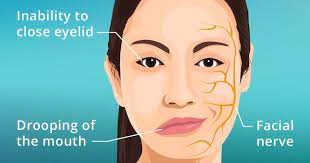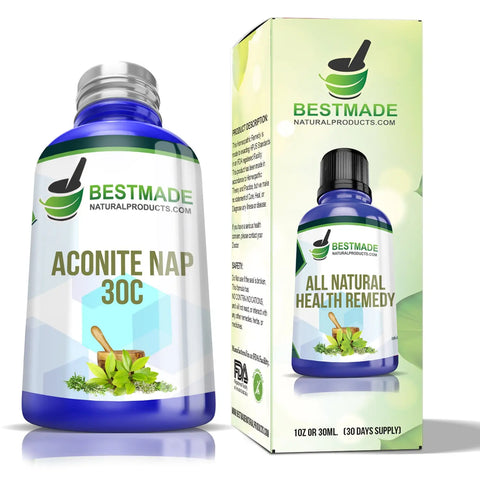
BELL’S PALSY (Facial Paralysis) of The Muscles
BM68 provides natural support for facial paralysis, facial drooping, and distortion; helps with the sting of tearing eyes, loss of taste, and the inability to close your eyes.
Having Bell’s Palsy can be hard and challenging, not just the medical and physical side, but also on a social and emotional side. People often look at those with Bell’s Palsy like they are weird, or like they are a freak. The problem is on the face so it is hard to hide it, and most people don’t know anything about this illness and condition.

What is a Bell’s Palsy
Bell’s palsy is a condition that causes a temporary weakness or paralysis of the muscles in the face. It can occur when the nerve that controls your facial muscles becomes inflamed, swollen, or compressed.
The condition causes one side of your face to droop or become stiff. You may have difficulty smiling or closing your eyes on the affected side. In most cases, Bell’s palsy is temporary and symptoms usually go away after a few weeks.
Although Bell’s palsy can occur at any age, the condition is more common among people between ages 15 and 60. It occurs most often in pregnant women, and people who have diabetes, influenza, a cold, or another upper respiratory ailment. Bell's palsy affects men and women equally.
Bell's palsy is not considered permanent, but in rare cases, it does not disappear. Currently, there is no known cure for Bell's palsy; however, recovery usually begins 2 weeks to 6 months from the onset of the symptoms. Most people with Bell's palsy recover full facial strength and expression.
Bell’s palsy is named after the Scottish anatomist Charles Bell, who was the first to describe the condition.

WHAT CAUSES BELL'S PALSY?
Bell’s palsy occurs when the seventh cranial nerve becomes swollen or compressed, resulting in facial weakness or paralysis. The exact cause of this damage is unknown, but many medical researchers believe it’s most likely triggered by a viral infection.
The viruses/bacteria that have been linked to the development of Bell’s palsy include:
- herpes simplex, which causes cold sores and genital herpes
- HIV, which damages the immune system
- sarcoidosis, which causes organ inflammation
- herpes zoster virus, which causes chickenpox and shingles
- Epstein-Barr virus, which causes mononucleosis
- Lyme disease, which is a bacterial infection caused by infected ticks
- Diabetes
- High blood pressure
- Injury
- Toxins
- Guillain-Barré syndrome
- Myasthenia gravis
- Multiple sclerosis

WHAT ARE THE SYMPTOMS OF BELL'S PALSY?
The symptoms of Bell’s palsy can develop one to two weeks after you have a cold, ear infection, or eye infection. They usually appear abruptly, and you may notice them when you wake up in the morning or when you try to eat or drink.
Bell’s palsy is marked by a droopy appearance on one side of the face and the inability to open or close your eye on the affected side. In rare cases, Bell’s palsy may affect both sides of your face.
The symptoms of Bell's palsy include sudden weakness in your facial muscles. In most cases, the weakness is temporary and significantly improves over weeks. The weakness makes half of your face appear to droop. Your smile is one-sided, and your eye on that side resists closing.
Other signs and symptoms of Bell’s palsy include:
- drooling
- difficulty eating and drinking
- an inability to make facial expressions, such as smiling or frowning
- facial weakness
- muscle twitches in the face
- dry eye and mouth
- headache
- sensitivity to sound
- irritation of the eye on the involved side
Call your doctor immediately if you develop any of these symptoms. You should never self-diagnose Bell’s palsy. The symptoms can be similar to those of other serious conditions, such as a stroke or brain tumor.
Aconite Nap provides support for states of fear, anxiety, and restlessness. May help with sudden colds, pain, burning headaches, and eye irritation. Calm shocked nerves.
Key points about Bell's palsy
● Bell's palsy is an unexplained episode of facial muscle weakness or paralysis that usually resolves on its own and causes no complications.
● The cause of Bell’s palsy is unknown but is thought to be caused by inflammation affecting the body’s immune system. It is associated with other conditions such as diabetes.
● Symptoms of facial weakness or paralysis get worse over the first few days and start to improve in about 2 weeks.
● It can take 3 to 6 months to fully resolve.
● Treatment and eye care are important in treating Bell’s palsy.
How is Bell’s palsy diagnosed?
Your doctor will first perform a physical examination to determine the extent of the weakness in your facial muscles. They’ll also ask you questions about your symptoms, including when they occurred or when you first noticed them.
Your doctor can also use a variety of tests to make a Bell’s palsy diagnosis. These tests may include blood tests to check for the presence of a bacterial or viral infection.
Other conditions — such as a stroke, infections, Lyme disease and tumors — can cause facial muscle weakness that mimics Bell's palsy. If the cause of your symptoms isn't clear, your doctor may recommend other tests, including:
- Electromyography (EMG). This test can confirm the presence of nerve damage and determine its severity. An EMG measures the electrical activity of a muscle in response to stimulation and the nature and speed of the conduction of electrical impulses along a nerve.
- Imaging scans. Magnetic resonance imaging (MRI) or computerized tomography (CT) may be needed on occasion to rule out other possible sources of pressure on the facial nerve, such as a tumor or skull fracture.

What are the complications of Bell's palsy?
Bell’s palsy usually resolves in time and causes no long-term complications. However, during the illness most people with Bell’s palsy are unable to close their eyes on the affected side of their face. It is, therefore, important to protect the eye from drying at night or while working at a computer. Eye care may include eye drops during the day, ointment at bedtime, or a moisture chamber at night. This helps protect the cornea from being scratched.
Living with Bell's palsy
Bell’s palsy usually resolves in time and causes no long-term complications. It is important, however, to complete whatever treatment you are on. It is also crucial that you protect the affected eye from drying. Use of eye drops during the day and ointment at bedtime can protect the cornea from scratching.
TREATMENT OPTIONSMedications
Commonly used medications to treat Bell's palsy include:- Corticosteroids, such as prednisone, are powerful anti-inflammatory agents. If they can reduce the swelling of the facial nerve, it will fit more comfortably within the bony corridor that surrounds it. Corticosteroids may work best if they're started within several days of when your symptoms started.
- Antiviral drugs. The role of antivirals remains unsettled. Antivirals alone have shown no benefit compared with placebo. Antivirals added to steroids are possibly beneficial for some people with Bell's palsy, but this is still unproved.
However, despite this, valacyclovir (Valtrex) or acyclovir (Zovirax) is sometimes given in combination with prednisone in people with severe facial palsy.
Always bare in mind that all medicines have some serious side effects.
Physical therapy
Paralyzed muscles can shrink and shorten, causing permanent contractures. A physical therapist can teach you how to massage and exercise your facial muscles to help prevent this from occurring.
Surgery
In the past, decompression surgery was used to relieve the pressure on the facial nerve by opening the bony passage that the nerve passes through. Today, decompression surgery isn't recommended. Facial nerve injury and permanent hearing loss are possible risks associated with this surgery.
Rarely, plastic surgery may be needed to correct lasting facial nerve problems. Facial reanimation helps to make the face look more even and may restore facial movement. Examples of this type of surgery include eyebrow lift, eyelid lift, facial implants and nerve grafts. Some procedures, such as an eyebrow lift, may need to be repeated after several years.
Nux Vomica is designed to support your body when dealing with vomiting and nausea.
Lifestyle and home remedies
Home treatment may include:- Protecting the eye you can't close. Using lubricating eye drops during the day and an eye ointment at night will help keep your eye moist. Wearing glasses or goggles during the day and an eye patch at night can protect your eye from getting poked or scratched.
- Doing your physical therapy exercises. Massaging and exercising your face according to your physical therapist's advice may help relax your facial muscles.
Alternative medicine
Some people with the Bell’s palsy condition may benefit from the following:
Acupuncture.
This needle-based Chinese therapy may help lessen facial paralysis and facial disability in people with Bell's palsy, according to a review of the scientific literature published in 2015. Placing thin needles into a specific point in your skin helps stimulate nerves and muscles, which may offer some relief.
Biofeedback training.
Biofeedback is a practice that involves learning to control vital functions that are usually unconscious (such as breathing, heart rate, and blood pressure) through the use of specialized electronic devices. Some studies have suggested that biofeedback, alone or combined with facial exercises, may promote recovery from Bell's palsy. A 2018 study found that facial biofeedback rehabilitation may prevent people with Bell's palsy from later developing something called oral-ocular synkinesis, in which smiling causes one eye to close.
Face yoga.
People with Bell’s palsy tend to develop synkinesis (a neurological symptom in which a voluntary action causes a simultaneous involuntary contraction of other muscles) and by doing these facial exercises slowly, you can help prevent synkinesis. Once your symptoms are settled and you move into a recovery phase and/or treatment, you can start some facial exercises. Always start your practice with the Warm Up Poses. The focus of your Face Yoga practice should be creating a sense of awareness, both between breaths and during the poses. 
Belladonna may help your body deal with fever and dryness of the mouth and throat.
Homeopathy
Homoeopathy is evidenced to be effective and safe in the treatment of Bell's palsy. The best part: it has no side-effects.
Homeopathy helps to ease pain in Bell’s palsy; it also improves the tone and strength of the facial muscles. It provides long-term results; it helps to avoid the use of the scalpel [surgery].
Homoeopathic treatment for facial, or Bell’s, palsy depends upon one’s personality, their unique symptoms and overall constitution. While your homeopath may prescribe a homeopathic remedy based on injury caused prior to getting Bell's palsy, there is a remedy that is most suitable when there is nerve damage and the jaw begins to lock. When the mouth and face begin to feel stiff, with the patient being sensitive to cold air, your homeopath will likewise prescribe a different remedy.
For optimum results, it is, of course, imperative for one to consult a professional homeopathic physician.

Although Bell’s palsy is mostly curable and in just a few cases permanent, there are some more things you can do to try and prevent it or help cure it:
- Eat a healthy and balanced diet, rich in leafy, green vegetables
- Do regular exercise
- Get a facial massage; perform facial exercises
- Increase your intake of vitamin B-12, B-6 and zinc supplements for good nerve health
- Keep blood sugar and blood pressure levels under control
- Apply moist heat applications to the paralysed area to reduce pain
- Keep your face warm — wear a scarf, or a jacket, with a hood, because exposure to cold while travelling aggravates the condition
- Drink fruit juice, water or cold drinks, with a straw
- Cut food into small pieces and eat on the side of your mouth that feels comfortable
- Practice relaxation techniques, such as meditation, to beat stress.

BM82 provides effective natural support for aging skin. Boost collagen production. It may manage face wrinkles, and sun and environmental toxins damage. It promotes healthy skin cells.BIO23 is best used for tooth and nerve pain. Promotes the regeneration of nerves and enamel after dental work or surgery. The anti-spasmodic properties of this combination product offer support for involuntary muscle contractions that lead to jaw pain.Mag Phos is best used for stabbing nerve pain, muscle spasms, and twitching. Recommended for spasms, hiccups, or menstrual cramps. It is an excellent antispasmodic and useful for muscular neuralgia, headaches, toothaches, dysmenorrhoea, and more.









My husband was diagnosed with MULTIPLE SCLEROSIS five years ago. It’s very difficult for me to get him on board with major changes to his diet. We eat organic, non-GMO at home but his mom constantly gives us donuts, bagels, etc. I feel so lucky and happy i found World Herbs clinic on the internet. My husband only used their MS HERBAL FORMULA for three months and He was fully recovered. I believe this will be of great help to all MS patients across the world. World Herbs clinic MS formula will reverse your condition, So go for it.
My husband was diagnosed with MULTIPLE SCLEROSIS five years ago. It’s very difficult for me to get him on board with major changes to his diet. We eat organic, non-GMO at home but his mom constantly gives us donuts, bagels, etc. I feel so lucky and happy i found World Herbs clinic on the internet. My husband only used their MS HERBAL FORMULA for three months and He was fully recovered. I believe this will be of great help to all MS patients across the world. World Herbs clinic MS formula will reverse your condition, So go for it.
Leave a comment